Can I enjoy pheasant shooting in my wheelchair?
We’re all looking to the season ahead. But what if you’ve recently found yourself confined to a wheelchair – or…
Win CENS ProFlex DX5 earplugs worth £1,149 – enter here
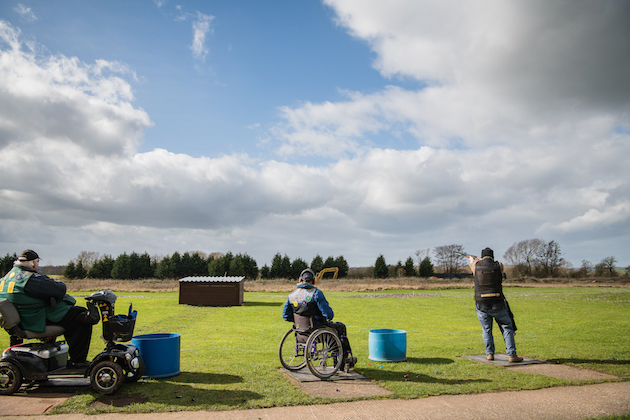 Kelvin Davies, Adrian Last and Sam Nunn shooting on DTL?
Usd 20 march 19 disabled shooting
Kelvin Davies, Adrian Last and Sam Nunn shooting on DTL?
Usd 20 march 19 disabled shooting
Disabled sport’s profile has risen hugely in recent years, partly driven by the success of British athletes in the Paralympics. I was therefore interested to see how far the disability sport revolution had reached into fieldsports. I sought out some of the UK’s leading practitioners from the worlds of clayshooting, game shooting and fishing.
My first stop was at the Doveridge clay ground in Derbyshire where the Disabled Shooters Group (DSG) was holding its first clay shoot of the year. I joined the team of Sam Nunn, Kelvin Davies, Marcus Watkin, Chris Proverbs and Adrian Last. These were the Sporting clays specialists; another team had gone off to tackle the Olympic Trap.
Group secretary Sam was shooting first. We had spent the morning working round the Sporting layouts and Sam had shot impressively, breaking his first four left-to-right high crossers in four shots and smashing pairs of clays with neat precision. The rabbit baffled him a few times, but not much else had survived unbroken.
“Skeet is probably my best discipline,” he confided. “It’s not my favourite, but it is the one I’m best at.” In 2015 at the open Skeet championship Sam had hit 96 out of 100 targets, breaking the last 50 without a single miss. Remarkably the man next to him, Adrian Last, had achieved the same thing on the same day.
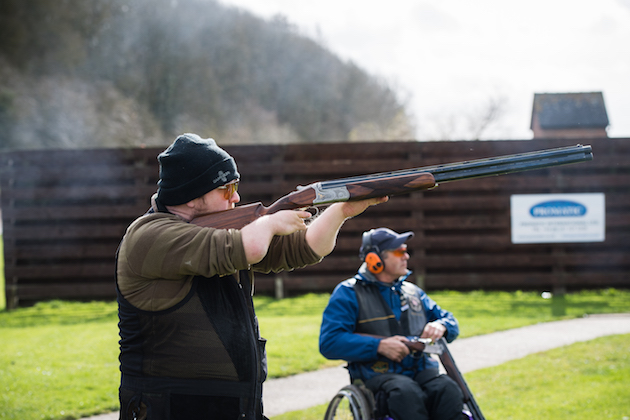
Sam Nunn takes aim as Adrian Last looks on; Sam decided to take up clayshooting seriously in 2012
Sam was born with FFU — femur-fibula-ulna complex. In simple terms this means both his arms are shortened, he has three fingers on each hand and he has a prosthetic leg. The result is that much of the conventional shooting technique simply doesn’t apply to Sam. He pulls the trigger with his thumb and grips his gun by pushing his hands in opposite directions. His prosthetic leg makes the idea of taking a quick step to reposition his body impossible, so he needs to think clearly in advance about how he is going to shoot.
Sam is fiercely competitive. He took up clayshooting seriously in 2012 when he was forced to stop playing football. His workmates suggested the Paralympics. Sam’s first memory is of his grandfather shooting a rat in his chicken coop, so naturally he turned to shooting.
It worked well for him; two years later he was Clay Pigeon Shooting Association (CPSA) disabled shooter of the year, winner of the Disabled Standing category in the English Open Sporting Championship, third in his able-bodied class and finished in the top 12 of the Essex masters. Following this, Gamebore chose to support him with cartridges at cost and he flourished his Gamebore Platinums in front of the camera like a pro.
Adrian Last, a farmer’s son who was paralysed in Motocross accident in 1990, was a vital part of bringing Sam into competitive clayshooting. “We bring out the best in each other,” he said, and Sam nodded vigorously. “Definitely. We push each other, but we don’t compete,” Sam claimed. After spending half a day observing the almost wolfish way they watched each other’s hits and misses, I wasn’t convinced by the claim they weren’t competing.
The end of the disabled categories in the FITASC Sporting competition has now denied these Sporting clay shooters the opportunity to compete internationally. Before the change, Adrian won a string of medals, including World and European golds. His list of shooting accomplishments is matched only by his extraordinary list of injuries from motorbike and other vehicle crashes.
Adrian shoots from a wheelchair fitted with a powered front wheel. Getting around clay grounds in a wheelchair is one of the main challenges for disabled clay shooters. Many grounds were never designed with wheelchair users in mind. The Skeet and Down-the-line layouts, which are based round a semicircular concrete path, are generally quite accessible. However, the Sporting layouts are much more of a problem and often facilities such as clubhouses and toilets are often impossible to access. Doveridge is one of the few clay grounds where almost everything is wheelchair-accessible.
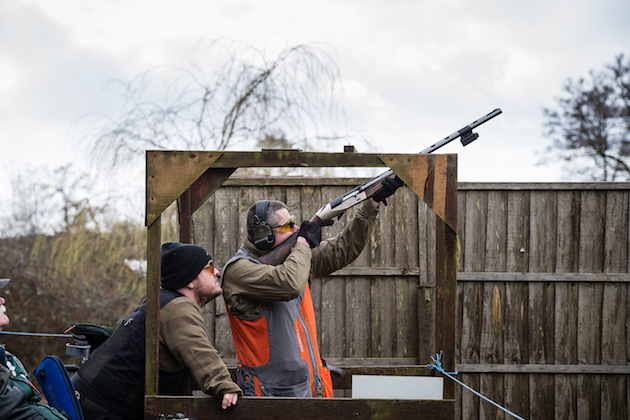
Sam Nunn watches as Chris Proverbs shoots clays
Not all of the members of the group have Adrian and Sam’s experience. Chris Proverbs, a soldier from London, has only been shooting for a few months. A trip on the stairs at work damaged his spine and left him unable to control or even feel his right leg. During his rehabilitation programme he was introduced to clay shooting. He enjoyed it and found the DSG through Twitter. This was his first outing with the group.
With only a few months’ experience Chris is not connecting with the clays as consistently as the other shooters. But there is a professionalism and focus to the way he analyses his shooting, every hit and miss recorded on a camera for later analysis. As I watched and refereed, Marcus hit 21 out of 25 targets on the Down-the-line layout, pulling off some astonishing long shots to beat Sam and Adrian.
The other group members offered Chris help and advice as it was sought, telling him where to shoot, how much lead to give and where he missed. Wisdom is liberally dispensed but no allowances are made. When the experienced Guns shot targets on report Chris did so too; when they got a simultaneous pair so did he; and when, on the Skeet, he shot the low bird before the high one he was docked his hits. It seemed harsh to me, but Chris cheerfully accepted it.
Frequently insisting he needed to go home now, Chris moved from layout to layout, with Sam feeding his habit by supplying him with cartridges. By the end of the day he was clearly spent, leaning on the wall of the low house to give himself a rest before calling for his final pair.
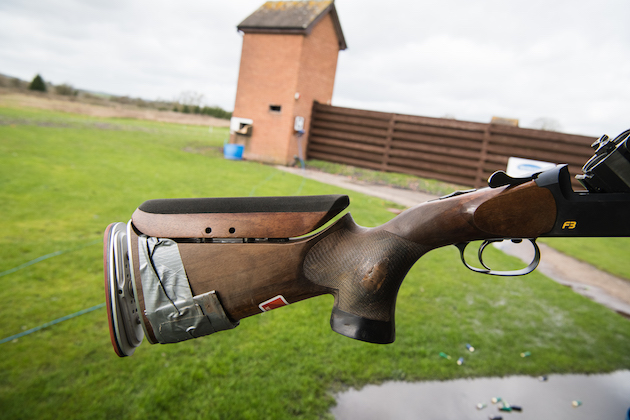
Modifications to a shotgun help to provide a better shooting experience
Bill Elderkin of Elderkin & Son Gunmakers in Spalding, Lincolnshire, was another early starter. Bill comes from a long line of shooters and gunsmiths. In his youth he shot Skeet competitively and it was driving home from a clay ground that he had the accident which damaged his spine and put him in a wheelchair.
After seven months in hospital, Bill returned to the family business but, as the workshop was upstairs, he initially worked in a managerial capacity. His use of a wheelchair did not stop Bill from taking part in the sport he loves and he soon returned to clay and game shooting.
Being paralysed from the chest down meant he had no control over his legs nor stomach muscles and he had to adapt his technique accordingly. After experimenting with various approaches, he finally settled on shooting one-handed, using his right arm and a relatively heavy gun to reduce any flip.
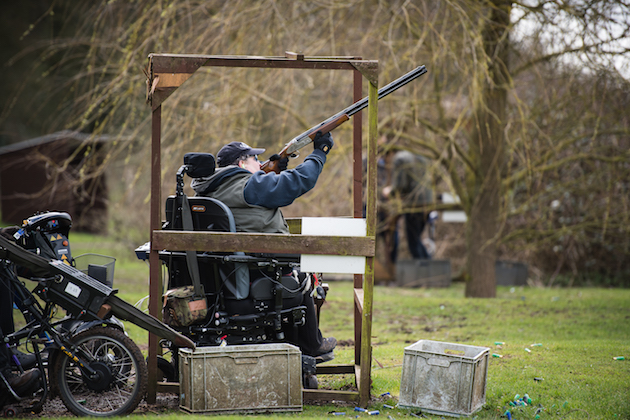
Marcus Watkin pulled off some incredible shots and hit 21 out of 25 targets
Four-wheel drive all-terrain vehicles (ATVs) have kept Bill game shooting. He started with an Argocat that he said “could go anywhere, but was the most uncomfortable thing”. Now he uses a Polaris ACE with the frame removed. He tows the buggy behind his car and has used it on everything from grouse to pigeons.
Compared with many UK sports, shooting and fishing are relatively accessible for disabled people. Powered wheelchairs and ATVs allow access to more and more places. Disability access legislation requires business owners to make reasonable adaptations for disabled people to use facilities so we can expect clay grounds and fisheries to become increasingly accessible.
We’re all looking to the season ahead. But what if you’ve recently found yourself confined to a wheelchair – or…
Nowadays there is a whole selection of cartridges designed specifically for clays. Some are general-purpose, some for specific disciplines like…
The costs of taking part in disabled shooting remain relatively high, but organisations such as the Disabled Shooters Group support keen members financially when they can. The role of disabled people in fieldsports looks set to be significant in years to come.
Get the latest news delivered direct to your door
Discover the ultimate companion for field sports enthusiasts with Shooting Times & Country Magazine, the UK’s leading weekly publication that has been at the forefront of shooting culture since 1882. Subscribers gain access to expert tips, comprehensive gear reviews, seasonal advice and a vibrant community of like-minded shooters.
Save on shop price when you subscribe with weekly issues featuring in-depth articles on gundog training, exclusive member offers and access to the digital back issue library. A Shooting Times & Country subscription is more than a magazine, don’t just read about the countryside; immerse yourself in its most authoritative and engaging publication.

